Abstract
Phosphonated polyethylenimine grafted on iron oxide nanoparticles was used as a magnetic support for loading palladium. This cheap and accessible heterogeneous catalyst demonstrated good efficiency in Suzuki-Miyaura, Mizoroki-Heck, and Tsuji-Trost couplings. The nanocomposite is resistant to harsh conditions and can therefore be recycled up to 10 cycles with high catalyst efficiency.
1. Introduction
Polyethylenimine (PEI) is a hyperbranched polymer available with different degrees of cross-linking. It is commercial, inexpensive, and available in different molecular weights. It can be readily phosphonated with different conversion rates by the reaction of Moedritzer and Irani [1]. The introduction of more or less numerous phosphonate groups can greatly change its properties. If the phosphonate content is high, we have shown that it is possible to obtain materials able to extract metals [2] or to act as anti-corrosion agents [2]. If PEI is partially phosphonated polyethylenimine PEIP are obtained, characterized by the coexistence of amino and phosphonate groups providing the polymer amphoteric properties. Partially phosphonated PEIP turned out to be an excellent polymer for the coating of iron oxide nanoparticles [3]. The convenient and versatile platform NP-PEIP [2] has also been used to immobilize enzymes [4], in particular trypsin. In that case [4], the higher stability of the peptidase allowed its recycling during the study of the structures of peptides.
Many palladium catalysts on magnetic nanoparticles were described recently [5,6,7]. Among them, the iron oxide nanoparticles were directly covered by palladium, attached through hydroxyl groups on the surface [8,9,10,11]. This approach often results in a higher amount of catalyst required for coupling because of the possible aggregation of nanoparticles, which are not dispersed in the reaction solution. Many catalysts consist of a silica layer covering an iron oxide or cobalt magnetic core. The subsequent palladium insertion allows preparation of various catalysts, with good conversion yields. However, most of the coupling reactions need a base, which also reacts with the Si-O-Si silica backbone at the same time. This destruction of the coating is intensified by the heating and has been proved by TEM studies [10]. The recyclability is consequently very limited. Alternative methods include the coating of a magnetic core with polymers, by electrostatic attraction or covalent bonding [11,12,13]. In that case, the material becomes more robust, improving its efficiency. However, the polymers supporting a palladium complex are often prepared in many steps and therefore become hard to access by non-specialized laboratories, and it can be a drawback for scaling up [14,15,16,17,18].
The aim of this study was to propose the platform NP-PEIP as a palladium-based catalyst suitable for common carbon-carbon couplings, it is environmentally friendly and, above all, easy to prepare.
Supermagnetic maghemite nanoparticles (γ-Fe2O3) were chosen instead of magnetite (Fe3O4) due to their general use but they are also easier to prepare. The phosphonate groups spread on the polymer PEIP bind strongly to the maghemite particle surface, leading to a material that is highly resistant to hydrolysis and high temperatures. It has been proved that these P-O-Fe covalent bonds are more stable than the C-O-Fe or N-Fe, which can readily desorb [19]. Consequently, PEIP-grafted particles are more stable than their counterpart coated with PEI.
Palladium chloride is directly immobilized on the magnetic platform through the amino ligands, without the previous modification step. The covalent coating with polymer approach was adopted, to ensure better preservation of the metallic catalyst integrity under harsh conditions and therefore higher recyclability. The hyperbranched structure and high molecular weight are the keys to loading high amounts of palladium. Catalyst efficiency has been assessed for three types of usual C-C coupling: Suzuki-Miyaura, Mizoroki-Heck, and Tsuji-Trost reactions.
2. Materials and Methods
2.1. Characterizations
Transmission electron microscopy images were obtained with a 200 kV Jeol 2010 FEG transmission electron microscope fitted with a double tilt sample holder (tilt ± 42°). The cationic composition of the materials was determined by energy dispersive X-ray analysis (EDX) using EDAX analyzers coupled with the microscope. The samples for the transmission electron microscopy TEM image were deposited and then dried onto a copper grid covered with a perforated carbon film. At least 50 particles were measured to obtain the average diameter. The NMR measurements were carried out on a Bruker DRX 400 NMR spectrometer operating at 400 MHz for 1H and 31P using D2O as solvent. Inductively coupled plasma−atomic emission spectroscopy (ICP-AES) on a Varian Vista MPX spectrometer was used to detect the palladium, phosphorus, and iron contents. A Varian SpectrAA 55 AAS was used to detect potential traces of iron or palladium in the supernatants after catalysis.
2.2. Synthetic Procedure
2.2.1. Preparation of Maghemite Nanoparticles [20,21]
Maghemite ionic ferrofluid was obtained by wet alkaline co-precipitation of ferric chloride FeCl3 and ferrous chloride FeCl2 with a molar ratio of 1:2, in the presence of ammonium hydroxide solution (28%), at room temperature and under mechanical stirring. Then, a solution of iron (III) nitrate in concentrated nitric acid was added at 80 °C under stirring. After the removal of the supernatant, nanoparticles were washed with acetone and diethylether and then redispersed in a controlled volume of water. The pH of the ionic ferrofluid is about 2, with NO3− as counterion. Nanoparticles are nearly spherical, with an average diameter of 7.5 nm determined by XRD.
2.2.2. Phosphonation of Polyethylenimine [22]
Phosphonated polyethylenimine PEIP with 5% of amino groups modified was prepared by mixing 3.81 g (4.65 × 10−2 mol) of phosphorous acid and 10 g (4 × 10−4 mol) of PEI 20 Da in 30 mL of water, and the mixture was irradiated at 150 W for 1 min in a microwave oven. 10 mL of concentrated HCl and 9.30 × 10−2 mol of a 35% formaldehyde solution were successively added. After 5 min of irradiation at 150 W, excess formaldehyde was removed under vacuum and the yellow solution was dialyzed with a nitrocellulose membrane, yielding 85% of PEIP.
2.2.3. Coating of Maghemite Nanoparticles with PEIP
5 mL of ferrofluid in water ([Fe] = 10−4 mol) was slowly added to 10 mL of a PEIP solution (30 mg.mL−1) and adjusted to pH 2 with diluted nitric acid (10%) under vigorous stirring. 20 mL of a sodium hydroxide solution (1 mol.L−1) was added to precipitate the particles. Supernatant was removed and particles were redispersed in 10 mL of nitric acid (10%) solution. Then acetone was added until the flocculation was observed. Supernatant was removed and the precipitate nanoparticles were redispersed in water at the concentration of ([Fe] = 10−2 mol.L−1).
2.2.4. Synthesis of Palladium Cluster Supported Catalyst NP-PEIP@Pd
To 1 mL of the NP-PEIP solution prepared above was added 5 mL of a 5 × 10−3 mol.L−1 solution of Na2PdCl4, prepared by mixing 20 mg of PdCl2 and 20 mg of NaCl in 25 mL of distilled water. After 24 h of stirring, 30 mg of NaBH4 (7.5 × 10−5 mol, 3 eq.) was added and allowed to stir for another 24 h. NaOH pellets were added to the reaction mixture until the nanoparticles formed a brown precipitate. The supernatant was removed and replaced with distilled water acidified with 0.4 mL of 65% nitric acid. The nanoparticles precipitate was redispersed as a brown aqueous liquid by ultrasonication. This operation was repeated 3 times. Acetone in excess was then added until flocculation of particles. Supernatant was eliminated and aggregate was washed thoroughly with acetone and ether, then dried at 100 °C for 12 h to form a dark powder. Before coupling, the catalyst in the powder was dispersed in water at a concentration of 2 g.L−1.
2.2.5. General Procedure for Suzuki-Miyaura Cross-Couplings (see Table 1 and Table 2)
0.78 mmol (2 eq.) of the base was added to a solution of 0.39 mmol of aryl halide and 0.41 mmol (1.05 eq.) of the boronic derivative dissolved in 20 mL of a 1:1 water/ethanol mixture. While stirring under argon atmosphere, 1 mg of catalyst in aqueous solution was added and the mixture was carried out at 80 °C for 3 h. Catalyst was removed with the application of an external magnetic field, and supernatant was acidified with sulfuric acid (20%). Organic phases were extracted with diethyl ether (3 × 20 mL), combined, dried over MgSO4, and evaporated under vacuum. The product was purified on a silica gel chromatography column using a 5:1 cyclohexane/ethyl acetate.



Table 1.
Selection of bases for NP-PEIP@Pd catalysis.
Table 1.
Selection of bases for NP-PEIP@Pd catalysis.
 | |||
|---|---|---|---|
| Entry | X | Base | Yield 1 (%) |
| 1 | I | NaOH | 92 |
| 2 | I | K2CO3 | 97 |
| 3 | I | KOH | 90 |
| 4 | I | K3PO4 | 91 |
| 5 | I | NEt3 | 91 |
| 6 | Br | NaOH | 23 |
| 7 | Br | K2CO3 | 68 |
| 8 | Br | KOH | 31 |
| 9 | Br | K3PO4 | 31 |
| 10 | Br | NEt3 | 27 |
| 11 | Cl | NaOH | 16 |
| 12 | Cl | K2CO3 | 27 |
| 13 | Cl | KOH | 12 |
| 14 | Cl | K3PO4 | 11 |
| 15 | Cl | NEt3 | 9 |
1 Reaction conditions: aryl halide (0.39 mmol), toluene boronic acid (0.41 mmol), base (0.78 mmol) and NP-PEIP@Pd (1 mg) in water/ethanol (1:1, 20 mL) at 80 °C for 3 h. Isolated yields are obtained after purification.

Table 2.
Suzuki-Miyaura couplings involving halogenoarenes with phenylboronic acid with NP-PEIP@Pd catalysis.
Table 2.
Suzuki-Miyaura couplings involving halogenoarenes with phenylboronic acid with NP-PEIP@Pd catalysis.
 | ||||
|---|---|---|---|---|
| Entry | X | R1 | R2 | Yield 1 (%) |
| 1 | I | H | CO2Me | 91 |
| 2 | I | OH | H | 95 |
| 3 | I | NHCOMe | H | 84 |
| 4 | I | H | CN | 97 |
| 5 | I | H | CO2H | 96 |
| 6 | I | 1-iodo-2-methoxynaphthalene | 63 | |
| 7 | Br | OH | H | 62 |
| 8 | Br | H | CO2H | 81 |
| 9 | Br | H | CO2Me | 74 |
| 10 | Br | Acenaphthene-5-boronic acid | 27 | |
| 11 | Cl | H | CO2H | 35 |
| 12 | Cl | OH | H | 19 |
1 Reaction conditions: aryl halide (0.39 mmol), phenylboronic acid (0.41 mmol), K2CO3 (0.78 mmol) and NP-PEIP@Pd (1 mg) in water/ethanol (1:1, 20 mL) at 80 °C for 3 h. Isolated yields are obtained after purification.
2.2.6. General Procedure for Mizoroki-Heck Cross-Couplings
0.6 mmol (1.2 eq.) of the allylic derivative was added to 0.5 mmol of aryl halide dissolved in 5 mL water/ethyl acetate with 2% of tetrabutylammonium hydroxide (entries 2, 4, 6, 8, 10, 11, 12, 15 in Table 3) or alternatively in 5 mL of DMF (other entries Table 3), followed by 0.65 mmol (1.3 eq.) of triethylamine and 1 mg of the catalyst in an aqueous solution. The mixture was heated at 80 °C for 3 h. After cooling to room temperature, the catalyst was removed with the application of an external magnetic field. The mixture was poured into 15 mL of distilled water and acidified with sulfuric acid (20%). Organic phases were extracted with ethyl acetate (3 × 20 mL), combined, washed with brine water (15 mL), dried over MgSO4, and concentrated under vacuum. The crude product was purified on a silica gel column whenever needed using a 5:1 cyclohexane/ethyl acetate.

Table 3.
Use of NP-PEIP@Pd as catalyst in Mizoroki-Heck couplings.
2.2.7. Procedure for Tsuji-Trost Cross Couplings (see Table 4)
0.8 mmol of (E)-1,3-diphenylallyl compound and 1 eq. (0.8 mmol) of the nucleophile were successively added to 10 mL of ethyl acetate (and an additional 10 mL of distilled water in the case of (E)-3-hydroxy-1,3-diphenyl-prop-1-ene). Base was then added (0.1 mL of triethylamine in the case of acetate, 0.8 mmol of K2CO3 in the case of alcohol) followed by 1 mg of the catalyst in an aqueous solution. The reaction mixture was stirred at 50 °C for 12 h. The catalyst was removed with the application of an external magnetic field, and the supernatant was washed with brine. The organic layers were collected, dried over MgSO4, and evaporated under vacuum.


Table 4.
Tsuji-Trost reactions catalyzed by NP-PEIP@Pd.
Table 4.
Tsuji-Trost reactions catalyzed by NP-PEIP@Pd.
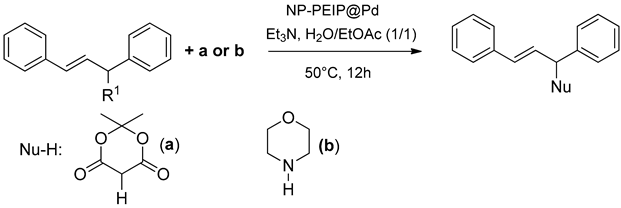 | |||
|---|---|---|---|
| Entry | R 1 | Nu-H (a or b) | Yield 1 (%) |
| 1 | OH | a | 54 |
| 2 | b | 65 | |
| 3 | OAc | a | 58 |
| 4 | b | 77 | |
1 Reaction conditions: allyl (3.9 mmol), nucleophile (3.9 mmol), triethylamine (3.9 mmol) and NP-PEIP@Pd (1 mg) in ethyl acetate/water (1:1, 20 mL) at 50 °C for 12 h. Isolated yields were obtained after purification. Nu-H = Nucleophile-H.
- Synthesis of (E)-3-hydroxy-1,3-diphenyl-prop-1-ene
11.5 g (46.5 mmol) of CeCl3 was added to 10 g (48.4 mmol) of chalcone dissolved in 100 mL of methanol. The mixture was cooled to −78 °C and 2.18 g (57.9 mmol) of NaBH4 was added in small parts. The reaction was allowed to continue under stirring at room temperature for 12 h. The mixture was then cooled to −10 °C and acidified with HCl 3 mol.L−1 until pH = 5, and solvents were removed under vacuum. 50 mL of cold water was added and the aqueous phase was then extracted with 3 × 50 mL of diethyl ether, washed with brine water and dried over MgSO4, filtered, and evaporated under vacuum yielding a white solid in a 95% yield.
- Synthesis of (E)-1,3-diphenyl-2-propenyl acetate
23.8 mmol of (E)-1,3-diphenylprop-2-en-1-ol was dissolved in 100 mL of anhydrous dichloromethane under inert atmosphere. 10% mol of DMAP (2.3 mmol) and 2 eq. of triethylamine (47.6 mmol, 6.6 mL) were successfully added dropwise. After cooling the mixture down to −5 °C, 2 eq. (47.6 mmol, 4.5 mL) of acetic anhydride were added dropwise. The reaction was stirred at room temperature for 12h. Acidity was neutralized with a saturated solution of NaHCO3. The organic layer was washed with brine and then dried over MgSO4 and filtered. The solvent was evaporated under vacuum to give a light yellow oil (4.06 g, yield 81%) that was ball-distilled under vacuum.
3. Results
3.1. Preparation and Characterization of the Catalyst
A full procedure for PEIP synthesis and characterization has been reported previously [22]. The reaction, derived from the Moedritzer- Irani method, is carried out in water by reacting a high molecular weight polyethylenimine with phosphorous acid, in the presence of formaldehyde and hydrochloric acid. The quantity of phosphorous acid is controlled in order that all the amines on the PEI do not react. As illustrated in Figure 1, only 5% of the amines are substituted by methylenephosphonate. On the other hand, an ionic ferrofluid of maghemite nanoparticles was also prepared following the coprecipitation method initiated by Massart [21,22]. Nitrate ions were chosen as anionic counterions in order to stabilize the dispersion.
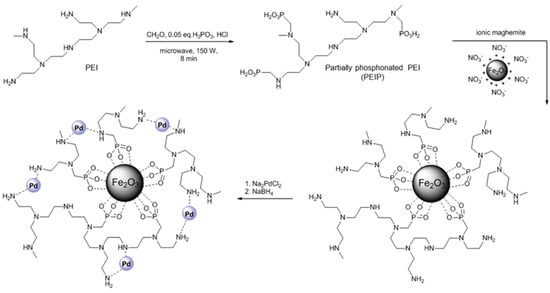
Figure 1.
Number of methylphosphonates introduced on the PEI is under control. Only 0.05 equivalent of phosphorous are added compared to the number of amines, N-H bonds are therefore available for palladium complexation. The palladium immobilization on PEIP-coated nanoparticles is carried out in two steps: after coupling PdCl2 on the free amino groups, the active species Pd (0) is obtained by reduction with sodium borohydride.
PEIP was bound on the surface of maghemite by mixing it with an ionic ferrofluid in acidic media. Particles remain dispersed during the grafting process by carrying out the reaction at pH 2, ammonium groups ensuring repulsion between nanoparticles.
Finally, palladium was loaded on the particles in two steps summarized in Figure 1. PEIP-coated nanoparticles (NP-PEIP) were first mixed with palladium (II) chloride in water. In that case, free amino groups are used as ligands to make the palladium complex (NP-PEIP@Pd). The Pd (II) was then reduced to the active species Pd (0) by the addition of sodium borohydride. The mass percentage of palladium in NP-PEIP@Pd was estimated to be 15.2% by ICP-AES, which is above the average of the existing magnetic nanocatalysts [23]. This high amount captured by the particles was mainly attributed to two reasons, the many unreacted primary amines and the PEI’s high molecular weight (25,000 Da).
The NP-PEIP@Pd structure was first characterized by TEM. Nanoparticles before coating are shown in Figure 2A. They have a spherical shape and a diameter of about 7.5 nm. In Figure 2B, the polymer shell cannot be observed due to its low density. The presence of maghemite is attested by the lattice fringes, a feature of the crystalline structure. Dark spots of 1.5–2 nm are attributed to palladium clusters randomly spread all around according to EDS. The energy-dispersive X-ray detected the palladium peaks only in the presence of iron, nitrogen, and phosphorus, which come from the PEIP. No palladium was detected directly on the grid in the absence of these elements. Moreover, the average hydrodynamic diameter increased from 33 nm to 82 nm after the insertion of palladium (Figure 2C). The broader size distribution is attributed to the palladium clusters of polydispersed sizes.
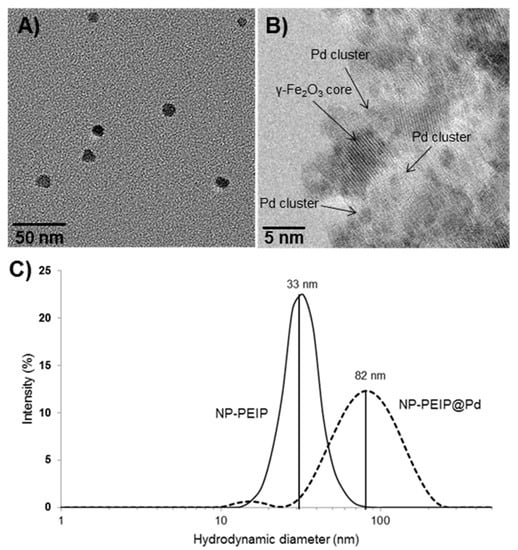
Figure 2.
(A) Maghemite nanoparticles were found to be 7.5 nm in diameter, with a quasi-spherical shape; (B) The core maghemite is distinguished by the lattice fringes. Around, smaller dark spots are attributed to the palladium clusters; (C) Hydrodynamic diameter before and after the loading of palladium.
3.2. NP-PEIP@Pd Reactivity
3.2.1. Suzuki-Miyaura Couplings
All the experiments presented were replicated three times, with yield variations lower than 5%. Parameters such as temperature, time, and bases were studied on a typical Suzuki coupling between p-tolylboronic acid and 1-bromo-4-methoxybenzene. Results related to the base selection are summarized in Table 1. We chose to run reactions in a water/ethanol mixture for the initial screening, with the aim of limiting the ecological impact as much as possible. 4-methoxy-4′-methyl-1,1′-biphenyl was obtained with a maximum yield of 97%, when the base was K2CO3, at 80 °C, in the presence of 50 μL of NP-PEIP-Pd ([Fe] = 2 × 10−3 mol.L−1). Other bases tested such as NaOH, KOH, K3PO4, and NEt3 resulted in lower yields, mainly leading to the concurrent homocoupling reaction. This trend was particularly noteworthy for aryl bromides and chlorides. Working with lower temperatures considerably extended the reaction time (up to 24 h), but did not increase the yield. It appears that at 80 °C, the coupling was at maximum after 3 h, and so we chose to use these reaction conditions throughout the study.
The optimum ratio of catalyst was determined by running the model reaction between p-tolylboronic acid and 1-bromo-4-methoxybenzene with different amounts of catalysts, and yields are recorded in Figure 3. The highest yield was obtained for 2.92 mg of NP-PEIP@Pd per mmol of the substrate. In fact, above that, the yield did not increase with further addition of the catalyst. Reported to the quantity of Pd, the molar percentage of the catalyst is equivalent to 0.45 mol%.
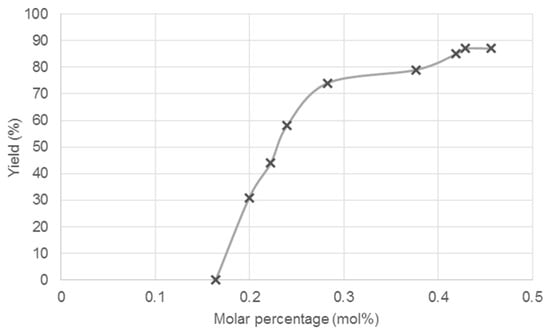
Figure 3.
Study of the mol% catalyst needed to obtain the best yield on Suzuki-Miyaura coupling between p-tolylboronic acid and 1-bromo-4-methoxybenzene.
The efficiency of the catalyst on the Suzuki-Miyaura coupling reaction was evaluated by reacting boronic acid with several chloro, bromo, and iodoarene derivatives. Experiments were carried out under the best-defined conditions described above, and the results are collected in Table 2.
All the aryl iodides bearing either an electron-withdrawing group or an electron-donating group afforded the corresponding substituted biphenyl in good yields, varying from 63 to 97% (entries 1 to 6). Bromobenzene with an electron-withdrawing group (entries 8, 9) reacted with phenylboronic acid to give the desired products, isolated with high yields. In the case of substitution by an electron-donating group, which corresponds to entry 7 for both Table 1 and Table 2, the corresponding products are also obtained in satisfactory yields. The low amount of isolated product resulting from acenaphthene-5-boronic acid coupling was attributed to the steric hindrance brought by the aromatic substituent.
Chlorobenzene derivatives reacted poorly, with a maximum yield of 35% when coupling was favored. According to the data collected by NMR, most of the reactant was converted into the homocoupling product in all of the cases.
3.2.2. Mizoroki-Heck Couplings
During the course of our study, we tested the different temperature and time conditions for the Heck couplings. Heating at 80 °C for 3 h was required for all the reactions to proceed to completion.
The reaction of a wide series of aryl halides and activated alkenes was examined using optimized conditions: the results are shown in Table 3. The reactions were carried out either in a mixture of water/ethyl acetate/tetrabutylammonium hydroxide when reagents were soluble (entries 2, 3, 5, 7, 8, 9, 12, 15) or in DMF (entries 1, 4, 6, 10, 11, 13, 14, 16, 17) as a last resort when compounds were insoluble.
The NP-PEIP@Pd efficiently promotes the Mizoroki-Heck coupling or both electron-rich and -poor aryl iodides (entries 1–5). The position of the substituents, ortho or para, does not seem to have a substantial influence. Coupling results with aryl bromides mainly depend on the nature of the substituents: activating substituents such as methoxy (entry 6) decrease the yields, whereas deactivating ones enhance the coupling. Similar conclusions can be made with aryl chlorides.
The nature of the alkene was also studied. To this purpose, two alkenes with the same backbone, methyl methacrylate (a) and ethyl acrylate (b) were used. By comparing pairs (entries 1–4, 7–8, 11–14, 12–15), we observed that the ethyl acrylate gives higher yields of 8% to 12%. Although the C=C double bond is more electron-rich for methacrylate, which should favor the reaction, it seems that the steric factor is predominantly displaying a better reactivity for acrylate.
Good results were also obtained from the intramolecular reaction involving the 1-iodo-2-methoxynaphthalene (entry 17). On the other hand, the coupling of coumarin and 4-iodobenzonitrile (entry 16) afforded a yield similar to the reaction with the ethyl acrylate (entry 10).
3.2.3. Tsuji-Trost Couplings
The 2,2-dimethyl-1,3-dioxane-4,6-dione, or Meldrum acid, and the morpholine were used as nucleophiles. The allylation was obtained by either the (E)-1,3-diphenylallyl acetate or the (E)-1,3-diphenylprop-2-en-1-ol. Reactions were carried out in an ethyl acetate/water mixture at 50 °C for 12 h. Even with a carbon based-nucleophile and a bad leaving group such as OH, the yield of the reaction remains acceptable.
3.3. Recyclability
The catalytic activity was assessed through the coupling of p-tolylboronic acid and 1-iodo-4-methoxybenzene in the optimal conditions described in entry 2 Table 1.
The results are reported in Figure 4. The efficiency remained high during five cycles (superior to 85%), then suddenly dropped to a level of 70%. Surprisingly, the yields do not decrease anymore in the next cycles. To investigate if the cause of the drop was a leak of palladium in the media, we carried out the same reaction but this time NP-PEIP@Pd was removed from the mixture with a magnet after only 30 min. The supernatant was mixed for another 1 h 30 without a catalyst. No evolution in the formation of the product was observed between the two samples, suggesting that no metal was released from the catalyst. Moreover, neither iron nor palladium was detected by atomic absorption in the supernatants after removing particles. So, we assumed that the decrease in activity after five cycles could be attributed to an agglomeration of the supported palladium in bigger clusters, decreasing the surface available for catalysis. It should be noted that the drop in efficiency after five cycles was reproduced in three series of 10 tests. Besides, the FTIR spectrum of the catalyst recovered after separation and drying was identical to the FTIR of the native catalyst.
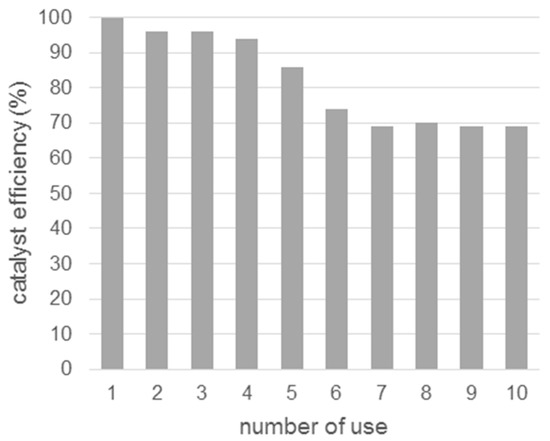
Figure 4.
Recyclability of the NP-PEIP@Pd catalyst for coupling p-tolylboronic acid and 1-iodo-4-methoxybenzene.
4. Conclusions
The platform NP-PEIP@Pd constitutes a low-cost heterogeneous catalyst developed for coupling reactions. It is particularly interesting for many reasons. First, it is prepared in simple steps, from polymer synthesis to palladium immobilization. Secondly, PEIP coating turned out to be very robust, not affected by any type of hydrolysis, whether acid or basic. It is therefore a good candidate for further larger-scale productions. In addition, for eventual use in continuous processes, maximum efficiency could be obtained by adding a small amount of NP-PEIP@Pd when the catalytic activity starts to decrease, avoiding the waste of the catalyst.
Author Contributions
Conceptualization, D.V.; Investigation, C.M., E.J. and N.B.; Writing—Original draft, C.M., N.B. and D.V.; Writing—Review and editing, N.B. and D.V. All authors have read and agreed to the published version of the manuscript.
Funding
This research received no external funding.
Institutional Review Board Statement
Not applicable.
Informed Consent Statement
Not applicable.
Data Availability Statement
Not applicable.
Acknowledgments
We gratefully acknowledge the CNRS (Centre National de la Recherche Scientifique) for their financial support.
Conflicts of Interest
The authors declare no conflict of interest.
References
- Moedritzer, K.; Irani, R.R. The Direct Synthesis of α-Aminomethylphosphonic Acids. Mannich-Type Reactions with Orthophosphorous Acid. J. Org. Chem. 1966, 31, 1603–1607. [Google Scholar] [CrossRef]
- Villemin, D.; Monteil, C.; Bar, N.; Didi, M.A. Phosphonated polyethyleneimines (PEIP) as multi-use polymers. Phosphorous Sulfur Silicone 2015, 190, 879–890. [Google Scholar] [CrossRef]
- Monteil, C.; Bar, N.; Moreau, B.; Retoux, R.; Bee, A.; Talbot, D.; Villemin, D. Phosphonated polyethylenimine coated nanoparticles: Elaboration of size and zeta potential adjustable nanomaterials. Part. Part. Syst. Char. 2014, 32, 219–227. [Google Scholar] [CrossRef]
- Monteil, C.; Bar, N.; Retoux, R.; Henry, J.; Bernay, B.; Villemin, D. Partially phosphonated polyethylenimine-coated nanoparticles as convenient support for enzyme immobilization in bioprocessing. Sens. Actuator B-Chem. 2014, 192, 269–274. [Google Scholar] [CrossRef]
- Dingzhong, Y.; Bin, H. Progress in organic synthesis reactions catalyzed by palladium supported on magnetic nanoparticles. Chin. J. Org. Chem. 2012, 32, 1368–1379. [Google Scholar] [CrossRef]
- Mulahmetovic, E.; Hargaden, G.C. Recent advances in the development of magnetic catalysts for the Suzuki reaction. Ref. J. Chem. 2017, 7, 373–398. [Google Scholar] [CrossRef]
- Nasrollahzadeh, M. Advances in magnetic nanoparticles -supported palladium complexes for coupling reactions. Molecules 2018, 23, 2532. [Google Scholar] [CrossRef]
- Ye, L.; Liu, X.; Lu, Y. A highly controllable, effective, and recyclable magnetic-nanoparticle-supported palladium catalyst for the Suzuki–Miyaura cross-coupling reaction. J. Cat. 2021, 397, 36–43. [Google Scholar] [CrossRef]
- Li, R.; Zhang, P.; Huang, Y.; Zhang, P.; Zhong, H.; Chen, Q. Pd–Fe3O4@C hybrid nanoparticles: Preparation, characterization, and their high catalytic activity toward Suzuki coupling reactions. J. Mat. Chem. 2012, 42, 22750–22755. [Google Scholar] [CrossRef]
- Mori, K.; Kondo, Y.; Yamashita, H. Synthesis and characterization of FePd magnetic nanoparticles modified with chiral BINAP ligand as a recoverable catalyst vehicle for the asymmetric coupling reaction. Phys. Chem. Chem. Phys. 2009, 11, 8949–8954. [Google Scholar] [CrossRef]
- Chung, J.; Kim, J.; Jang, Y.; Byun, S.; Hyeon, T.; Kim, B.M. Heck and Sonogashira cross-coupling reactions using recyclable Pd–Fe3O4 heterodimeric nanocrystal catalysts. Tetrahedron. Lett. 2013, 54, 5192–5196. [Google Scholar] [CrossRef]
- Wang, Z.; Xiao, P.; Shen, B.; He, N. Synthesis of palladium-coated magnetic nanoparticle and its application in Heck reaction. Coll. Surf. A Physicochem. Eng. Asp. 2006, 276, 116–121. [Google Scholar] [CrossRef]
- Jin, M.-J.; Lee, D.-H. A Practical Heterogeneous Catalyst for the Suzuki, Sonogashira, and Stille Coupling Reactions of Unreactive Aryl Chlorides. Angew. Chem. Inter. Ed. 2010, 49, 1119–1122. [Google Scholar] [CrossRef] [PubMed]
- Beygzadeh, M.; Alizadeh, A.; Khodaei, M.M.; Kordestani, D. Biguanide/Pd(OAc)2 immobilized on magnetic nanoparticle as a recyclable catalyst for the heterogeneous Suzuki reaction in aqueous media. Cat. Comm. 2013, 32, 86–91. [Google Scholar] [CrossRef]
- Costa, N.J.S.; Kiyohara, P.K.; Monteiro, A.L.; Coppel, Y.; Philippot, K.; Rossi, L.M. A single-step procedure for the preparation of palladium nanoparticles and a phosphine-functionalized support as catalyst for Suzuki cross-coupling reactions. J. Cat. 2010, 276, 382. [Google Scholar] [CrossRef]
- Yang, J.; Wang, D.; Liu, W.; Zhang, X.; Bian, F.; Yu, W. Palladium supported on a magnetic microgel: An efficient and recyclable catalyst for Suzuki and Heck reactions in water. Green Chem. 2013, 15, 3429–3437. [Google Scholar] [CrossRef]
- Yuan, D.; Chen, L.; Yuan, L.; Liao, S.; Yang, M.; Zhang, Q. Superparamagnetic polymer composite microspheres supported Schiff base palladium complex: An efficient and reusable catalyst for the Suzuki coupling reactions. Chem. Eng. J. 2016, 287, 241–251. [Google Scholar] [CrossRef]
- Veisi, H.; Sarachegol, P.; Hemmati, S. Palladium(II) anchored on polydopamine coated-magnetic nanoparticles (Fe3O4@PDA@Pd(II)): A heterogeneous and core–shell nanocatalyst in Buchwald–Hartwig C–N cross coupling reactions. Polyhedron 2018, 156, 64–71. [Google Scholar] [CrossRef]
- Mutin, P.H.; Guerrero, G.; Vioux, A. Hybrid materials from organophosphorus coupling molecules. J. Mater. Chem. 2005, 15, 3761–3768. [Google Scholar] [CrossRef]
- Massart, R. Preparation of aqueous magnetic liquids in alkaline and acidic media. IEEE Trans. Magn. 1981, 17, 1247–1248. [Google Scholar] [CrossRef]
- Lefebure, S.; Dubois, E.; Cabuil, V.; Neveu, S.; Massart, R. Monodisperse magnetic nanoparticles: Preparation and dispersion in water and oils. J. Mat. Res. 1998, 13, 2975–2981. [Google Scholar] [CrossRef]
- Villemin, D.; Moreau, B.; Elbilali, A.; Didi, M.A.; Kaid, M.; Jaffrès, P.-A. Green synthesis of poly(aminomethylenephosphonic) acids. Phosphorus Sulfur Silicon 2010, 185, 2511–2519. [Google Scholar] [CrossRef]
- Ghorbani-Choghamarani, A.; Norouzi, M. Suzuki, Stille and Heck cross-coupling reactions catalyzed by Fe3O4@PTA–Pd as a recyclable and efficient nanocatalyst in green solvents. New J. Chem. 2016, 40, 6299–6307. [Google Scholar] [CrossRef]
Publisher’s Note: MDPI stays neutral with regard to jurisdictional claims in published maps and institutional affiliations. |
© 2022 by the authors. Licensee MDPI, Basel, Switzerland. This article is an open access article distributed under the terms and conditions of the Creative Commons Attribution (CC BY) license (https://creativecommons.org/licenses/by/4.0/).

